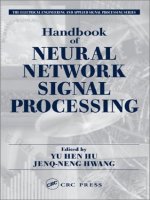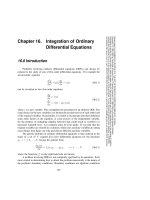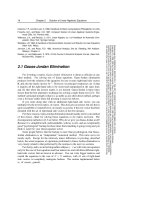Tài liệu Solution of Linear Algebraic Equations part 2 ppt
Bạn đang xem bản rút gọn của tài liệu. Xem và tải ngay bản đầy đủ của tài liệu tại đây (159.04 KB, 6 trang )
36
Chapter 2. Solution of Linear Algebraic Equations
Sample page from NUMERICAL RECIPES IN C: THE ART OF SCIENTIFIC COMPUTING (ISBN 0-521-43108-5)
Copyright (C) 1988-1992 by Cambridge University Press.Programs Copyright (C) 1988-1992 by Numerical Recipes Software.
Permission is granted for internet users to make one paper copy for their own personal use. Further reproduction, or any copying of machine-
readable files (including this one) to any servercomputer, is strictly prohibited. To order Numerical Recipes books,diskettes, or CDROMs
visit website or call 1-800-872-7423 (North America only),or send email to (outside North America).
Coleman, T.F., and Van Loan, C. 1988,
Handbook for Matrix Computations
(Philadelphia: S.I.A.M.).
Forsythe, G.E., and Moler, C.B. 1967,
Computer Solution of Linear Algebraic Systems
(Engle-
wood Cliffs, NJ: Prentice-Hall).
Wilkinson, J.H., and Reinsch, C. 1971,
Linear Algebra
,vol.IIof
Handbook for Automatic Com-
putation
(New York: Springer-Verlag).
Westlake, J.R. 1968,
A Handbook of Numerical Matrix Inversion and Solution of Linear Equations
(New York: Wiley).
Johnson, L.W., and Riess, R.D. 1982,
Numerical Analysis
, 2nd ed. (Reading, MA: Addison-
Wesley), Chapter 2.
Ralston, A., and Rabinowitz, P. 1978,
A First Course in Numerical Analysis
, 2nd ed. (New York:
McGraw-Hill), Chapter 9.
2.1 Gauss-Jordan Elimination
For inverting a matrix, Gauss-Jordan elimination is about as efficient as any
other method. For solving sets of linear equations, Gauss-Jordan elimination
produces both the solution of the equations for one or more right-hand side vectors
b, and also the matrix inverse A
−1
. However, its principal weaknesses are (i) that
it requires all the right-hand sides to be stored and manipulated at the same time,
and (ii) that when the inverse matrix is not desired, Gauss-Jordan is three times
slower than the best alternative technique for solving a single linear set (§2.3). The
method’s principal strength is that it is as stable as any other direct method, perhaps
even a bit more stable when full pivoting is used (see below).
If you come along later with an additional right-hand side vector, you can
multiplyit by the inverse matrix, of course. This does give an answer, but one that is
quite susceptible to roundoff error, not nearly as good as if the new vector had been
included with the set of right-hand side vectors in the first instance.
For these reasons, Gauss-Jordan elimination should usually not be your method
of first choice, either for solving linear equations or for matrix inversion. The
decomposition methods in §2.3 are better. Why do we give you Gauss-Jordan at all?
Because it is straightforward, understandable, solid as a rock, and an exceptionally
good “psychological” backup for those times that something is going wrong and you
think it might be your linear-equation solver.
Some people believe that the backup is more than psychological, that Gauss-
Jordan elimination is an “independent” numerical method. This turns out to be
mostly myth. Except for the relatively minor differences in pivoting, described
below, the actual sequence of operations performed in Gauss-Jordan elimination is
very closely related to that performed by the routines in the next two sections.
For clarity, andto avoid writingendless ellipses(···) we will writeout equations
only for the case of four equations and four unknowns, and with three different right-
hand side vectors that are known in advance. You can write bigger matrices and
extend the equations to the case of N × N matrices, with M sets of right-hand
side vectors, in completely analogous fashion. The routine implemented below
is, of course, general.
2.1 Gauss-Jordan Elimination
37
Sample page from NUMERICAL RECIPES IN C: THE ART OF SCIENTIFIC COMPUTING (ISBN 0-521-43108-5)
Copyright (C) 1988-1992 by Cambridge University Press.Programs Copyright (C) 1988-1992 by Numerical Recipes Software.
Permission is granted for internet users to make one paper copy for their own personal use. Further reproduction, or any copying of machine-
readable files (including this one) to any servercomputer, is strictly prohibited. To order Numerical Recipes books,diskettes, or CDROMs
visit website or call 1-800-872-7423 (North America only),or send email to (outside North America).
Elimination on Column-Augmented Matrices
Consider the linear matrix equation
a
11
a
12
a
13
a
14
a
21
a
22
a
23
a
24
a
31
a
32
a
33
a
34
a
41
a
42
a
43
a
44
·
x
11
x
21
x
31
x
41
x
12
x
22
x
32
x
42
x
13
x
23
x
33
x
43
y
11
y
12
y
13
y
14
y
21
y
22
y
23
y
24
y
31
y
32
y
33
y
34
y
41
y
42
y
43
y
44
=
b
11
b
21
b
31
b
41
b
12
b
22
b
32
b
42
b
13
b
23
b
33
b
43
1000
0100
0010
0001
(2.1.1)
Here the raised dot (·) signifies matrix multiplication, while the operator just
signifies column augmentation, that is, removing the abutting parentheses and
making a wider matrix out of the operands of the operator.
It should not take you long to write out equation (2.1.1) and to see that it simply
states that x
ij
is the ith component (i =1,2,3,4) of the vector solution of the jth
right-hand side (j =1,2,3), the one whose coefficients are b
ij
,i =1,2,3,4;and
that the matrix of unknown coefficients y
ij
is the inverse matrix of a
ij
.Inother
words, the matrix solution of
[A] · [x
1
x
2
x
3
Y]=[b
1
b
2
b
3
1](2.1.2)
where A and Y are square matrices, the b
i
’s and x
i
’s are column vectors, and 1 is
the identity matrix, simultaneously solves the linear sets
A · x
1
= b
1
A · x
2
= b
2
A · x
3
= b
3
(2.1.3)
and
A · Y = 1 (2.1.4)
Now it is also elementary to verify the following facts about (2.1.1):
• Interchanging any two rows of A and the corresponding rows of the b’s
and of 1, does not change (or scramble in any way) the solution x’s and
Y. Rather, it just corresponds to writing the same set of linear equations
in a different order.
• Likewise, the solution set is unchanged and in no way scrambled if we
replace any row in A by a linear combination of itself and any other row,
as long as we do the same linear combination of the rows of the b’s and 1
(which then is no longer the identity matrix, of course).
• Interchanging any two columns of A gives the same solution set only
if we simultaneously interchange corresponding rows of the x’s and of
Y. In other words, this interchange scrambles the order of the rows in
the solution. If we do this, we will need to unscramble the solution by
restoring the rows to their original order.
Gauss-Jordan elimination uses one or more of the above operations to reduce
the matrix A to the identity matrix. When this is accomplished, the right-hand side
becomes the solution set, as one sees instantly from (2.1.2).
38
Chapter 2. Solution of Linear Algebraic Equations
Sample page from NUMERICAL RECIPES IN C: THE ART OF SCIENTIFIC COMPUTING (ISBN 0-521-43108-5)
Copyright (C) 1988-1992 by Cambridge University Press.Programs Copyright (C) 1988-1992 by Numerical Recipes Software.
Permission is granted for internet users to make one paper copy for their own personal use. Further reproduction, or any copying of machine-
readable files (including this one) to any servercomputer, is strictly prohibited. To order Numerical Recipes books,diskettes, or CDROMs
visit website or call 1-800-872-7423 (North America only),or send email to (outside North America).
Pivoting
In “Gauss-Jordan elimination with no pivoting,” only the second operation in
the above list is used. The first row is divided by the element a
11
(this being a
trivial linear combination of the first row with any other row — zero coefficient for
the other row). Then the right amount of the first row is subtracted from each other
row to make all the remaining a
i1
’s zero. The first column of A now agrees with
the identity matrix. We move to the second column and divide the second row by
a
22
, then subtract the right amount of the second row from rows 1, 3, and 4, so as to
make their entries in the second column zero. The second column is now reduced
to the identity form. And so on for the third and fourth columns. As we do these
operations to A, we of course also do the corresponding operations to the b’s and to
1 (which by now no longer resembles the identity matrix in any way!).
Obviously we will run into trouble if we ever encounter a zero element on the
(then current) diagonal when we are going to divide by the diagonal element. (The
element that we divide by, incidentally, is called the pivot element or pivot.) Not so
obvious,but true, is the fact thatGauss-Jordan eliminationwithno pivoting(nouse of
the first or third procedures in the above list) is numerically unstable in the presence
of any roundoff error, even when a zero pivot is not encountered. You must never do
Gauss-Jordan elimination (or Gaussian elimination, see below) without pivoting!
So what is this magic pivoting? Nothing more than interchanging rows (partial
pivoting) or rows and columns (full pivoting), so as to put a particularly desirable
element in the diagonal position from which the pivot is about to be selected. Since
we don’t want to mess up the part of the identitymatrix that we have already builtup,
we can choose among elements that are both (i) on rows below (or on) the one that
is about to be normalized, and also (ii) on columns to the right (or on) the column
we are about to eliminate. Partial pivoting is easier than full pivoting, because we
don’t have to keep track of the permutation of the solution vector. Partial pivoting
makes available as pivots only the elements already in the correct column. It turns
out that partial pivoting is “almost” as good as full pivoting, in a sense that can be
made mathematically precise, but which need not concern us here (for discussion
and references, see
[1]
). To show you both variants, we do full pivoting in the routine
in this section, partial pivoting in §2.3.
We have to state how to recognize a particularly desirable pivot when we see
one. The answer to this is not completely known theoretically. It is known, both
theoretically and in practice, that simply picking the largest (in magnitude) available
element as the pivot is a very good choice. A curiosity of this procedure, however, is
thatthechoice of pivotwilldepend on the originalscaling of the equations. If we take
the third linear equation in our original set and multiply it by a factor of a million, it
is almost guaranteed that it will contribute the first pivot; yet the underlying solution
of the equations is not changed by this multiplication! One therefore sometimes sees
routines which choose as pivot that element which would have been largest if the
original equations had all been scaled to have their largest coefficient normalized to
unity. This is called implicit pivoting. There is some extra bookkeeping to keep track
of the scale factors by which the rows would have been multiplied. (The routines in
§2.3 include implicit pivoting, but the routine in this section does not.)
Finally, let us consider the storage requirements of the method. With a little
reflection you will see that at every stage of the algorithm,either an element of A is
2.1 Gauss-Jordan Elimination
39
Sample page from NUMERICAL RECIPES IN C: THE ART OF SCIENTIFIC COMPUTING (ISBN 0-521-43108-5)
Copyright (C) 1988-1992 by Cambridge University Press.Programs Copyright (C) 1988-1992 by Numerical Recipes Software.
Permission is granted for internet users to make one paper copy for their own personal use. Further reproduction, or any copying of machine-
readable files (including this one) to any servercomputer, is strictly prohibited. To order Numerical Recipes books,diskettes, or CDROMs
visit website or call 1-800-872-7423 (North America only),or send email to (outside North America).
predictably a one or zero (if it is already in a part of the matrix that has been reduced
to identity form) or else the exactly corresponding element of the matrix that started
as 1 is predictably a one or zero (if its mate in A has not been reduced to the identity
form). Therefore the matrix 1 does not have to exist as separate storage: The matrix
inverse of A is gradually built up in A as the original A is destroyed. Likewise,
the solution vectors x can gradually replace the right-hand side vectors b and share
the same storage, since after each column in A is reduced, the corresponding row
entry in the b’s is never again used.
Here is the routine for Gauss-Jordan elimination with full pivoting:
#include <math.h>
#include "nrutil.h"
#define SWAP(a,b) {temp=(a);(a)=(b);(b)=temp;}
void gaussj(float **a, int n, float **b, int m)
Linear equation solution by Gauss-Jordan elimination, equation (2.1.1) above.
a[1..n][1..n]
is the input matrix.
b[1..n][1..m]
is input containing the
m
right-hand side vectors. On
output,
a
is replaced by its matrix inverse, and
b
is replaced by the corresponding set of solution
vectors.
{
int *indxc,*indxr,*ipiv;
int i,icol,irow,j,k,l,ll;
float big,dum,pivinv,temp;
indxc=ivector(1,n); The integer arrays ipiv, indxr,andindxc are
used for bookkeeping on the pivoting.indxr=ivector(1,n);
ipiv=ivector(1,n);
for (j=1;j<=n;j++) ipiv[j]=0;
for (i=1;i<=n;i++) { This is the main loop over the columns to be
reduced.big=0.0;
for (j=1;j<=n;j++) This is the outer loop of the search for a pivot
element.if (ipiv[j] != 1)
for (k=1;k<=n;k++) {
if (ipiv[k] == 0) {
if (fabs(a[j][k]) >= big) {
big=fabs(a[j][k]);
irow=j;
icol=k;
}
} else if (ipiv[k] > 1) nrerror("gaussj: Singular Matrix-1");
}
++(ipiv[icol]);
We now have the pivot element, so we interchange rows, if needed, to put the pivot
element on the diagonal. The columns are not physically interchanged, only relabeled:
indxc[i], the column of the ith pivot element, is the ith column that is reduced, while
indxr[i] is the row in which that pivot element was originally located. If indxr[i] =
indxc[i] there is an implied column interchange. With this form of bookkeeping, the
solution b’s will end up in the correct order, and the inverse matrix will be scrambled
by columns.
if (irow != icol) {
for (l=1;l<=n;l++) SWAP(a[irow][l],a[icol][l])
for (l=1;l<=m;l++) SWAP(b[irow][l],b[icol][l])
}
indxr[i]=irow; We are now ready to divide the pivot row by the
pivot element, located at irow and icol.indxc[i]=icol;
if (a[icol][icol] == 0.0) nrerror("gaussj: Singular Matrix-2");
pivinv=1.0/a[icol][icol];
a[icol][icol]=1.0;
for (l=1;l<=n;l++) a[icol][l] *= pivinv;
for (l=1;l<=m;l++) b[icol][l] *= pivinv;
40
Chapter 2. Solution of Linear Algebraic Equations
Sample page from NUMERICAL RECIPES IN C: THE ART OF SCIENTIFIC COMPUTING (ISBN 0-521-43108-5)
Copyright (C) 1988-1992 by Cambridge University Press.Programs Copyright (C) 1988-1992 by Numerical Recipes Software.
Permission is granted for internet users to make one paper copy for their own personal use. Further reproduction, or any copying of machine-
readable files (including this one) to any servercomputer, is strictly prohibited. To order Numerical Recipes books,diskettes, or CDROMs
visit website or call 1-800-872-7423 (North America only),or send email to (outside North America).
for (ll=1;ll<=n;ll++) Next, we reduce the rows...
if (ll != icol) { ...except for the pivot one, of course.
dum=a[ll][icol];
a[ll][icol]=0.0;
for (l=1;l<=n;l++) a[ll][l] -= a[icol][l]*dum;
for (l=1;l<=m;l++) b[ll][l] -= b[icol][l]*dum;
}
}
This is the end of the main loop over columns of the reduction. It only remains to unscram-
ble the solution in view of the column interchanges. We do this by interchanging pairs of
columns in the reverse order that the permutation was built up.
for (l=n;l>=1;l--) {
if (indxr[l] != indxc[l])
for (k=1;k<=n;k++)
SWAP(a[k][indxr[l]],a[k][indxc[l]]);
} And we are done.
free_ivector(ipiv,1,n);
free_ivector(indxr,1,n);
free_ivector(indxc,1,n);
}
Row versus Column Elimination Strategies
The above discussion can be amplified by a modest amount of formalism. Row
operations on a matrix A correspond to pre- (that is, left-) multiplication by some simple
matrix R. For example, the matrix R with components
R
ij
=
1 if i = j and i =2,4
1 if i =2,j=4
1 if i =4,j=2
0 otherwise
(2.1.5)
effects the interchange of rows 2 and 4. Gauss-Jordan elimination by row operations alone
(including the possibility of partial pivoting) consists of a series of such left-multiplications,
yielding successively
A · x = b
(···R
3
·R
2
·R
1
·A)·x =···R
3
·R
2
·R
1
·b
(1)·x =···R
3
·R
2
·R
1
·b
x =···R
3
·R
2
·R
1
·b
(2.1.6)
The key point is that since the R’s build from right to left, the right-hand side is simply
transformed at each stage from one vector to another.
Column operations, on the other hand, correspond to post-, or right-, multiplications
by simple matrices, call them C. The matrix in equation (2.1.5), if right-multiplied onto a
matrix A, will interchange A’s second and fourth columns. Elimination by column operations
involves (conceptually) inserting a column operator, and also its inverse, between the matrix
A and the unknown vector x:
A · x = b
A · C
1
· C
−1
1
· x = b
A · C
1
· C
2
· C
−1
2
· C
−1
1
· x = b
(A · C
1
· C
2
· C
3
···)···C
−1
3
·C
−1
2
·C
−1
1
·x =b
(1)···C
−1
3
·C
−1
2
·C
−1
1
·x =b
(2.1.7)









